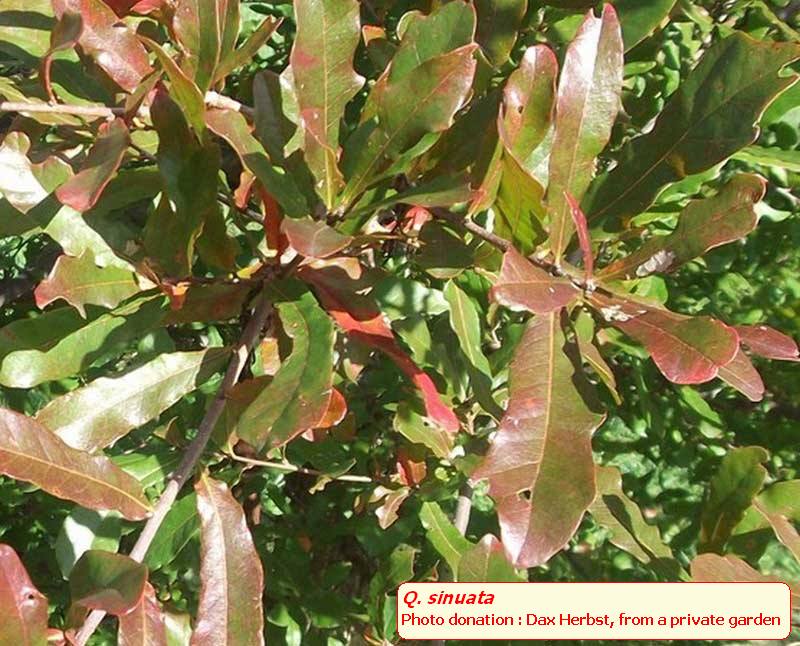| Quercus sinuata | |
| Author | Walt. 1788 Fl. Carol. 235 |
| Synonyms | durandii
Buckley 1861 (Camus n° 263). undulata Engelm. 1878 |
| Local names | bastard
oak ; bastard white oak ; Durand oak ; |
| Range |
USA (Alabama, Arkansas, Florida, Georgia, Louisiana, Mississippi, North
Carolina, Oklahoma, South Carolina, Texas); Mexico ( |
| Growth habit | often
a shrub, but may reach 20 metres tall; crown rounded; single trunk; |
| Leaves | 4-12
x 2.5-6 cm; oblanceolate to oblong; apex broadly rounded; base cuneate;
margin entire or with few lobes or only wavy near apex; dull green, hairless
above; dull green, pubescent beneath with 8-10 rays stellate hairs, sometimes
hairless; 7-11 vein pairs; petiole 3-5 mm long; |
| Flowers | in March; pistillate inflorescence very short, bearing 1 or 2 cups; |
| Fruits | acorn
1,2-1.8 cm; almost round or ovoid to oblong; brown; sessile or nearly
so; singly or paired; cup shallow, enclosing 1/4 or less of nut, with
appressed, smooth, greyish scales; maturing in 1 year in October; |
|
Bark, twigs and |
bark
light grey, thin, scaly; twig tawny, hairless or minutely pubescent, rough;
buds brown, ovoid, 2-6 cm long, hairless but ciliate margin; |
| Hardiness zone, habitat | hardy zone 5-6; all types of soils; prefers moist, calcareous sites; |
| Miscellaneous | --
Sub-genus Quercus, Section Quercus, Series Stellatae; -- This taxon has been often confused with Q.nigra, because of the likeness of leaves, but the latter belongs to the Sub-genus Quercus, section Lobatae, therefore they have nothing in common ! -- Elias Magloire Durand (1794-1873) = botanist at Philadelphia ; -- Hybridizes with Q.stellata (= x macnabiana) --The term "undulata" inspired numerous Authors ! One can list the following : Q.undulata Engelm 1878 (= Q.sinuata Walt.), Q.undulata Kit.1863 (= Q.pubescens Willd.), Q.undulata Benth. 1841 (= Q.benthamii A.DC), Q.undulata K.Koch 1847 (= Q.lusitanica Lam.), Q.undulata Torr 1827 (= Q.x undulata complex Little 1979), Q.undulata Sarg., and A.DC ( describing more or less Q.x pauciloba ...), Q.undulata S. Wats. (= Q.gambelii Nutt.) ; -- The term "durandii" is currently considered as "nomen confusum", because it was given by Buckley to some taxons he considered as varieties, whereas we know today they are separate species (= Q.austrina, Q.sinuata var. sinuata and Q.sinuata var. breviloba); |
| Subspecies and varieties |
-
var. sinuata -
var. breviloba (Torr.) C.H.Muller 1944 J. Arnold Arbor.
25: 439 |
| Pictures |
|





